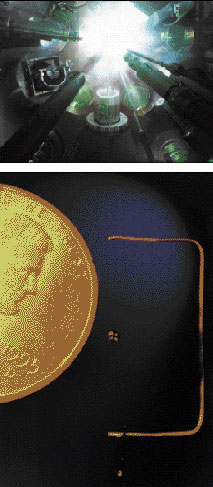Daniel C. McCarthy, Senior News Editor
The sun is fueled by fusion. Its gravitational field compresses elements such as hydrogen under high temperatures until the molecules fuse and release energy. The process is both efficient and clean, prompting scientists in nuclear stewardship and alternative energy programs to study how fusion can work for them.
One approach to initiating fusion uses the fuel's own inertia -- instead of gravity -- and the energy from high-power lasers. This technique, called inertial confinement fusion, requires spherical hydrogen-filled targets that have consistent roundness and wall thickness so that the laser energy uniformly accelerates the shell and fuel inward. General Atomics, which manufactures these targets, gauges the thickness of the shells nondestructively using a thin-film measurement system from Filmetrics Inc. The targets range from 0.5 to 2 mm, and have wall thicknesses between 1 and 50 µm.
Filmetrics' compact system uses spectral reflectance to measure wall thickness along the same path that an atomic force microscope measures surface profile. It fits into the limited available space with the aid of a fiber optic focusing lens less than 2 mm in diameter. Both the top and bottom of the target's shell reflect light from a tungsten-halogen source and combine their total reflection constructively or destructively, depending on their phase relationship. This relationship is determined by the difference in optical path lengths of each reflection, which is determined by the thickness of the film, its optical constants and the wavelength of the light.

Scientists are learning the secrets of nuclear fusion by focusing high-power lasers (above) on small, spherical, hydrogen-filled capsules like the one at right. Nondestructive spectral reflectance is helping to ensure that the targets have uniform shape and wall thickness. Courtesy of the University of Rochester.
"We couldn't measure thickness before," explained Richard Stephens, a senior technical adviser for General Atomics. "We're dealing with round, and the rest of the world is flat. There are lots of ways to measure thickness using a detector on one side and some sort of device on the other, but there are not a lot that measure thickness from one side [of a sphere]." The Filmetrics instrument is accurate to 1 nm for a 500-nm-thick layer.
"If all goes well, the shell pushes on the gas inside, which compresses under the energy of the laser to a density 20 times that of lead -- 600 g/cc," Stephen explained. "If vaporization of the shell isn't exactly uniform, then you get a mess analogous to stepping on a tube of toothpaste."